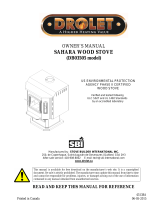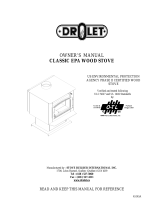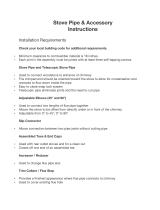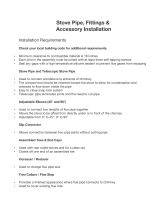
2
TABLE OF CONTENTS
TECHNICAL SPECIFICATIONS......................................................................................................................... 3
TIPS ON WOOD HEATING.................................................................................................................................. 4
SECTION 1.0 - INSTALLATION.......................................................................................................................... 5
1.1 GENERAL INSTALLATION.................................................................................................................... 5
1.2 POSITIONING THE STOVE.................................................................................................................... 5
1.3 CLEARANCES ........................................................................................................................................... 5
1.3.1 Reduced clearances using shielding................................................................................................. 7
1.4 FLOOR PROTECTOR............................................................................................................................... 8
SECTION 2.0 CHIMNEY (FLUE SYSTEM)....................................................................................................... 9
2.1 DEFINITIONS............................................................................................................................................. 9
2.2 CHIMNEY................................................................................................................................................... 9
2.2.1 Step by step installation of your factory-built chimney ................................................................. 11
2.2.2 Typical installation through an existing masonry chimney............................................................ 19
2.3 CHIMNEY CONNECTOR ...................................................................................................................... 22
2.4 DRAFT....................................................................................................................................................... 23
2.5 OUTSIDE COMBUSTION AIR.............................................................................................................. 23
2.6 THE ADVANTAGE OF INSTALLING A BLOWER (FAN)............................................................... 24
SECTION 3.0 OPERATION .............................................................................................................. 25
3.1 SAFETY INFORMATION....................................................................................................................... 25
3.2 FUEL.......................................................................................................................................................... 26
3.2.1 The use of manufactured logs ........................................................................................................ 27
3.2.2 Simple wood moisture test............................................................................................................. 28
3.3
NOTES ABOUT FIRST FIRING............................................................................................................ 28
3.4 LIGHTING A FIRE.................................................................................................................................. 28
3.5 MAINTAINING THE FIRE .................................................................................................................... 29
3.6 FAN (BLOWER) OPERATION.............................................................................................................. 29
SECTION 4.0 MAINTENANCE........................................................................................................ 30
4.1 CLEANING AND PAINTING YOUR STOVE...................................................................................... 30
4.2 GLASS........................................................................................................................................................ 30
4.3 GASKETING............................................................................................................................................. 30
4.4 ASH REMOVAL USING THE ASH DRAWER.................................................................................... 31
4.5 CHIMNEY (FLUE) CLEANING............................................................................................................. 32
DROLET LIMITED LIFETIME WARRANTY................................................................................................. 33





























